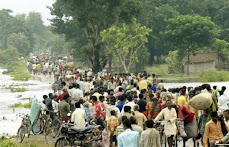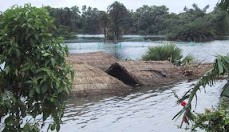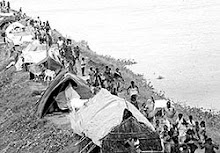I just read the story "कटते हुए वनों का शोकगीत" in The Public Agenda, which draws our attention towards the disturbing trend of reduction in the forest cover of Nepal at the rate of 270 ha/ day, the role of mafia iand Maoists in the Himalayan forests, ten fold increase in the rate of siltation in Kosi in the last 26-27 years. and the sad plight of Ganga. I was amused to note that you have completely ignored the contribution of misplaced structural engineering intervention, massive land use change and deforestation on the Indian side despite the fact that 79 % of the Ganga basin is in India. Hopefully, Ranjit Kumar, the writer of the story will deal with it in his next article. Participating in an group discussion on the internet, Kumar made a submission that "only techonology is not responsible for kosi disaster. Corruption played major roll in the failure of kosi project".
He has missed the role of corruption in the drafting of Kosi project plan and Kosi treaty, intellectual dishonesty of people like Dr K L Rao, Kanwar Sen and Nilendu Sanyal and the failure of Bihar Vidhan Sabha in dealing with vested interests has led to the choice of embankment technique as a "temporary solution". And now "multipurpose" High Dam and Interlinking of Rivers within BIhar as a "permanent solution" for flood/drainage crisis is fraught with grave ecological consequences. The environmental crisis in Kosi region could be deemed one of Asia's biggest environmental disaster. The culprits must be identified and made accountable.
Refusing to learn anything from the drainage crisis in the Kosi region, when govt engineers recommend and promote the same failed and discredited embankment technique for the Baghmati region, it is understandable why sensible engineers like Dr V N Sharma and others get outraged.
On the role of jornalists, when it comes to news reporting on the Kosi river, I read a content analysis of the coverage in Nepal and India and that Indian journalists commit the same kind of error year after year after year. The analysis noted that one gets to see more news on the Kosi barrage under the control and operation by Bihar govt emerging from Nepal-based media houses rather than in the Indian media.
It appears that the hydrocracy of Bihar never informs the Bihar journalists the truth of what is going on at Kosi barrage and embankment fronts of both Kosi, Baghmatiand all the rivers you mention in your news report.
Joining the debate Dr Dinesh Kumar Mishra, a well known river basin expert wrote: "Corruption is an outfall of programmes that were not intended to yield results. When everybody except the so called benificiaries knew that the results cannot be achieved, they thought to make hay while the sun shines by telling lies, whilte lies and what not. When the planning was corrupt, it would only lead to corruption. Someone became Minister at the Center, somebody got national decorations like Padma Bhushan etc and the others were made chairpersons of various committees and so on. One of the senior Congressman had termed Kosi Project as Kamadhenu and Kalpataru. You stand under Kalpataru and ask for anything you would get it or if you ask Kamdhenu for any favour, she is there to fulfill it, he is on record to have said this in Bihar Vidhan Sabha. Those who did not ask for laurels, asked for money and got it. I have a sincere feeling that corruption is a non-issue in such projects, it is a corollary. If one wants to know more, look for 50th and 53rd Report of the Estimates Committee of Bihar Vidhan Sabha (1973) and score of such documents that talk about loot devided by four among engineers, contactors, politicians and bureaucrats. There is a saying in Bangla that a person dug holes in the ground looking for earth worms and he found snakes coming out. Try it, you will find snakes instead of earthworms."
Historically, floods and their control have never been a big issue in the Ganga-Brahmaputra basin, as it is today. Floods became a major issue after the British occupied India. When they examined the Ganga basin, they believed that if it could be made “flood-free”, they could levy a tax in return for such protection.
Friday, 25 September 2009
Subscribe to:
Posts (Atom)







